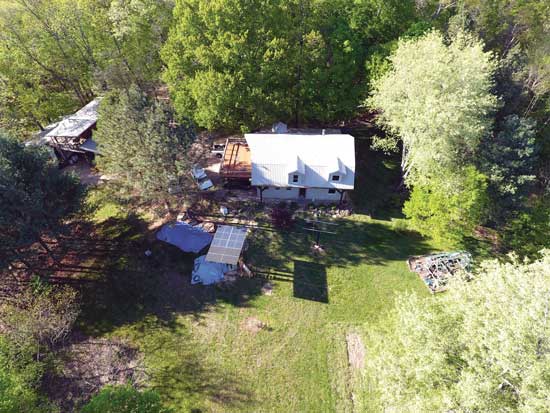In today’s digital age, internet access is no longer a luxury but a necessity.
However, relying on traditional internet connectivity can be unreliable and expensive, especially when living off the grid.
From poor cell reception to limited satellite coverage, connecting to the web in remote areas can be daunting.
But with the right tools and strategies, you can overcome these challenges and enjoy reliable and fast internet access even without the comfort of a traditional network.
We’ll delve into the common connectivity issues faced by those living off the grid and explore solutions to help you navigate these challenges with ease.
Determine your connectivity needs
Before selecting an internet solution, consider your specific connectivity requirements. How many devices do you need to connect? What speeds and bandwidth do you require?
This includes the number of devices you need to connect, the speeds and bandwidth you require, and the level of reliability and stability you expect from your internet service.
For instance, if you have a small business with only a few employees and basic internet needs, a slower and less expensive internet plan may suffice.
However, if you have a larger business with multiple locations, a more comprehensive and high-speed internet solution may be necessary to ensure seamless connectivity and uninterrupted access to critical applications and services.
Moreover, the type of devices you need to connect will also play a significant role in determining the appropriate internet solution for your business.
If you have a mix of older and newer devices, you may require a more versatile and adaptable internet plan that can accommodate various connection speeds and protocols.
If you plan to use your internet connection for data-intensive applications such as video conferencing, online backups, or cloud-based services, you will need to ensure that your internet plan provides adequate bandwidth and speed to support these activities.
Before selecting an internet solution for your business, it is essential to carefully consider your specific connectivity requirements, including the number of devices you need to connect, the speeds and bandwidth you require, and the level of reliability and stability you expect.
By doing so, you can select an internet solution that meets your unique needs and supports your business goals.
Choose the right technology
Off-grid internet solutions come in various forms, including satellite, cellular, and fixed wireless. Each technology has its own strengths and weaknesses, so select the one that best fits your needs and location.
When it comes to off-grid internet solutions, there are several options available, each with its own unique strengths and weaknesses.
Satellite internet, for example, provides fast and reliable connectivity, even in remote areas, but can be more expensive and susceptible to signal degradation due to heavy tree cover or adverse weather conditions.
Cellular internet, on the other hand, is more affordable and can be easily installed in most areas, but may not offer the same level of speed and reliability as satellite internet, especially in remote or mountainous regions.
Fixed wireless internet is another option that utilizes a wireless transmitter to connect to a nearby tower, offering a more stable and faster connection compared to cellular internet.
However, it may require a larger upfront cost and more complex installation process.
Ultimately, the best off-grid internet solution for you will depend on your specific needs and location.
If you live in a remote area with limited access to traditional internet services, satellite internet may be the best option.
If you prioritize affordability and convenience, cellular internet may be the way to go.
And if you’re looking for a more stable and faster connection, fixed wireless internet is worth considering.
It’s important to research and compare the available options in your area to find the one that best fits your needs and budget.
Assess your location
Rural areas and remote locations can present unique challenges when it comes to internet connectivity. Obstacles like hills, trees, and buildings can block signals, so it’s important to assess your location before selecting an internet solution.
Rural areas and remote locations often pose unique challenges when it comes to internet connectivity.
Physical obstacles such as hills, trees, and buildings can significantly impact the quality and reliability of internet signals, making it important to assess your location before selecting an internet solution.
For instance, if your home is located in a valley surrounded by hills or mountains, the signal from a nearby tower may be blocked or weakened, resulting in slow speeds or frequent disconnections.
Similarly, if your home is surrounded by tall trees or buildings, the signal may be obstructed, causing connectivity issues.
To overcome these challenges, it’s important to choose an internet service provider that offers a solution tailored to your specific location and needs.
This may involve utilizing alternative technologies such as satellite internet or mobile hotspots, or selecting a provider that offers customized network solutions and infrastructure.
By taking these factors into account and selecting the right internet solution for your unique location, you can ensure reliable and high-speed internet access, even in rural or remote areas.
Consider alternative solutions
In some cases, off-grid internet solutions may not be feasible due to infrastructure or geographical limitations. Alternative solutions like mobile hotspots or repeaters may be a better option.
In some cases, off-grid internet solutions may not be feasible due to infrastructure or geographical limitations.
This can be particularly true for those living in remote or mountainous areas where internet connectivity is scarce or non-existent.
In such cases, alternative solutions like mobile hotspots or repeaters may be a better option.
Mobile hotspots allow users to connect to the internet via a mobile network, while repeaters amplify existing signals to improve internet connectivity.
These solutions can provide reliable and efficient internet access, even in areas with limited infrastructure.
Mobile hotspots and repeaters can be easily transported, making them ideal for those who need to stay connected while on the move.
By exploring alternative solutions like mobile hotspots and repeaters, individuals can find a reliable and accessible internet connection, even in areas with limited infrastructure.
Install the necessary infrastructure
Depending on the internet solution you choose, you may need to install infrastructure like antennas, towers, or cabling. Make sure to follow all manufacturer guidelines and safety precautions when installing infrastructure.
Installing infrastructure for an internet solution can be a important step in ensuring a reliable and high-quality connection.
Depending on the type of internet solution you choose, you may need to install various types of infrastructure, such as antennas, towers, or cabling.
It is essential to follow all manufacturer guidelines and safety precautions when installing this infrastructure to avoid any potential risks or issues.
Antennas are a common piece of infrastructure used for internet solutions, and they come in different sizes and shapes depending on the specific application.
When installing antennas, it is important to ensure that they are placed in a location that is safe and accessible, and that they are securely fastened to prevent any damage or movement.
It is important to follow all safety precautions when handling antennas, such as wearing protective gear and avoiding any exposed wiring or components.
Towers are another essential piece of infrastructure for internet solutions, and they are typically used for wireless connections.
When installing towers, it is important to ensure that they are properly anchored and secured to prevent any collapse or movement.
It is important to follow all safety precautions when climbing towers, such as wearing proper footwear and using fall protection equipment.
Cabling is also an essential piece of infrastructure for internet solutions, and it is used for both wired and wireless connections.
When installing cabling, it is important to ensure that it is properly routed and secured to prevent any damage or interference.
It is important to follow all safety precautions when handling cabling, such as avoiding any exposed wiring or components and wearing protective gear.
Overall, installing infrastructure for an internet solution requires careful planning and attention to detail to ensure a reliable and high-quality connection.
It is essential to follow all manufacturer guidelines and safety precautions when installing infrastructure, and to regularly maintain and inspect it to prevent any issues or malfunctions.]]
Depending on the internet solution you choose, installing infrastructure such as antennas, towers, or cabling is a important step to ensure a reliable and high-quality connection.
The type of infrastructure you need will depend on the specific solution you choose, and it is important to carefully plan and execute the installation to ensure proper functionality and safety.
For example, when installing towers, it is important to properly anchor and secure them to prevent any collapse or movement.
This can be achieved through the use of secure foundation systems, such as concrete footings or anchored ground anchors.
It is important to follow all safety precautions when climbing towers, such as wearing proper footwear and using fall protection equipment.
Properly secured towers can provide a stable and reliable wireless connection.
Cabling is another essential piece of infrastructure for internet connectivity.
It is important to use high-quality, heavy-duty cables that are designed to withstand the rigors of long-term use and harsh environmental conditions.
Regular maintenance and inspection of cables is necessary to prevent any issues or malfunctions.
This includes checking for fraying or damage, and replacing cables as needed.
Regular maintenance and inspection of all infrastructure is important to ensure optimal performance and prevent any potential issues.
This can include monitoring signal strength, checking for damage or degradation of equipment, and performing regular software updates.
Proper maintenance and inspection can help prevent equipment failure, improve connection quality, and ensure a long-lasting and reliable internet solution.
Choose the right provider
Off-grid internet solutions are not all created equal, and providers offer varying levels of service and support. Choose a provider that offers reliable service, appropriate speeds, and adequate customer support.
When it comes to off-grid internet solutions, not all providers are created equal.
While some may offer comparable speeds and reliability to traditional internet service providers, others may fall short in terms of customer support and overall quality of service.
As such, it’s essential to carefully research and evaluate potential providers before making a decision.
One key consideration is the speed and capacity of the internet service.
Off-grid internet solutions may not be able to provide the same level of speed and bandwidth as traditional internet service, so it’s important to choose a provider that offers appropriate speeds for your needs.
For example, if you plan to use the internet for basic tasks such as email and social media, a lower-speed connection may be sufficient.
However, if you plan to use the internet for more data-intensive activities such as streaming video or online gaming, you’ll need a higher-speed connection.
Another important factor is customer support.
Off-grid internet solutions may be more susceptible to technical issues and outages, so it’s important to choose a provider that offers adequate customer support.
Look for a provider that offers a dedicated support team, available by phone or email, and that has a good track record of resolving issues quickly and effectively.
Consider the overall quality of service offered by the provider.
Off-grid internet solutions may be more prone to interference and other issues, so it’s important to choose a provider that has a strong track record of providing reliable service.
Look for reviews and testimonials from other customers to get a sense of the provider’s reputation and level of service.
By carefully evaluating these factors, you can choose an off-grid internet solution that meets your needs and provides reliable, high-quality service.
Plan for maintenance and upkeep
Off-grid internet solutions may require more maintenance and upkeep compared to traditional internet services. Plan for regular equipment checks, software updates, and any potential issues that may arise.
Off-grid internet solutions, such as satellite internet or mobile hotspots, may require more maintenance and upkeep compared to traditional internet services.
This is because these systems are often more susceptible to interference and signal loss, which can result in unreliable connectivity.
To ensure optimal performance and minimize downtime, it is essential to perform regular equipment checks and software updates.
This may include checking the antenna, LNB, and modem for any signs of damage or wear and tear, and updating the firmware to ensure compatibility with the latest technology.
It is important to monitor for any potential issues that may arise, such as signal strength, connectivity problems, or hardware failures.
By staying proactive and addressing these issues promptly, you can ensure a reliable and high-quality internet experience.
Consider future-proofing
Technology is constantly evolving, and it’s important to consider future-proofing when selecting an off-grid internet solution. Choose a solution that is flexible and scalable to ensure it can adapt to changing needs and advancements in technology.
When selecting an off-grid internet solution, it’s important to consider the future needs of your remote community or business.
Technology is constantly evolving, and what may be suitable today may not meet your needs in the long run.
To ensure that your internet solution remains relevant and effective, choose a solution that is flexible and scalable.
This means selecting a solution that can adapt to changing needs and advancements in technology.
For instance, if you choose a satellite internet solution that is easily upgradable and has a scalable bandwidth, you can ensure that your internet connection will remain robust and reliable even as your needs change over time.
Consider a solution that supports the latest internet protocols and standards to ensure compatibility with future technologies.
By investing in a future-proof off-grid internet solution, you can save time and resources in the long run, and ensure that your remote community or business remains connected and productive.
Want More? Dive Deeper Here!
Hey there! If you’re the type who loves going down the rabbit hole of information (like we do), you’re in the right spot. We’ve pulled together some cool reads and resources that dive a bit deeper into the stuff we chat about on our site. Whether you’re just killing time or super into the topic, these picks might just be what you’re looking for. Happy reading!






